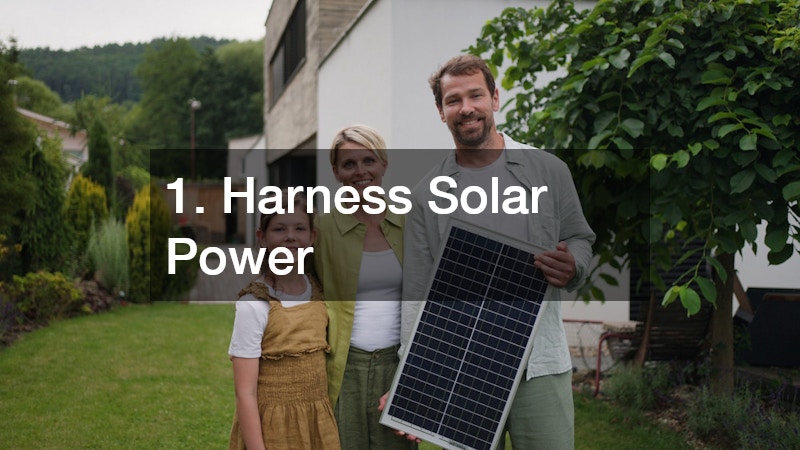Making your home more eco-friendly doesn’t have to feel like a big chore. Small changes, smart habits, and thoughtful upgrades can all add up to a greener, more sustainable lifestyle. Whether you’re new to the world of eco-conscious living or you’ve been slowly incorporating green habits, this guide has something for everyone. Let’s dive into 10 ways you can green your home and daily routine—without sacrificing comfort or convenience.
1. Harness Solar Power

Harnessing the power of the sun has never been easier or more accessible. Solar energy isn’t just for people with giant, high-tech homes—it’s something almost anyone can explore, even with limited space. By capturing sunlight and turning it into electricity, you can reduce your reliance on conventional power sources and lower your monthly bills. Many homeowners are surprised at how much energy a small system can produce, enough to run essentials and lighten the load on your energy grid.
Investing in solar panels is one of the most effective ways to bring solar energy into your home. Modern panels are more efficient, durable, and affordable than ever, making it possible for homeowners to generate a significant portion of their electricity from sunlight.
Going solar isn’t just about installing panels. Consider other ways to maximize solar power in your home:
-
Passive solar design: Orient windows and rooms to naturally capture sunlight for heating.
-
Solar water heaters: Use sunlight to warm your water instead of relying solely on electricity.
-
Portable solar gadgets: Charge small devices or power outdoor lights using compact solar chargers.
Even minor steps toward solar energy can make your home greener and put you on a path toward long-term sustainability.
2. Switch to Energy-Efficient Appliances
Old appliances can be sneaky energy vampires. A refrigerator or washing machine from 10–15 years ago can use far more electricity than newer, energy-efficient models. By upgrading to Energy Star-rated appliances or other energy-saving options, you can reduce your energy consumption significantly and cut down on your utility bills. Energy-efficient appliances aren’t just better for the environment—they can also save you time and effort with smarter features.
Tips for smart appliance choices include:
-
Look for the Energy Star label: It guarantees better efficiency without compromising performance.
-
Consider size and usage: Bigger isn’t always better; pick appliances that fit your household needs.
-
Unplug unused devices: Even when turned off, some electronics still draw power, so unplug chargers, entertainment systems, or kitchen gadgets when not in use.
-
Maintenance matters: Keep appliances clean and in good repair to maximize efficiency. For example, regularly defrost your freezer, clean refrigerator coils, and run washing machines with descaling cycles.
-
Smart features can help: Some appliances now offer energy-saving modes, delayed starts, or load-sensing capabilities that adjust energy use automatically.
Making the switch may require some upfront investment, but the energy and cost savings over time often make it well worth it. Plus, newer appliances often come with upgraded features that make daily life a little easier and more convenient, giving you a home that’s both greener and smarter.
3. Heat and Cool Smartly

Heating and cooling account for a huge chunk of energy use in most homes, so it’s one of the biggest opportunities for going green. Smart thermostats and home systems let you heat or cool your space efficiently without sacrificing comfort. By adjusting temperatures based on occupancy or time of day, you can significantly cut energy waste. Advanced systems even learn your habits and optimize energy use automatically, making comfort and sustainability work hand-in-hand.
One increasingly popular way to heat and cool efficiently is through geothermal systems. These systems use the stable temperature of the earth to regulate indoor climate, providing consistent warmth in winter and coolness in summer. Installing a geothermal system usually involves geothermal drilling, which taps into underground heat sources, but the long-term energy savings and reduced environmental impact can be significant.
Other strategies for smarter temperature control include:
-
Use ceiling fans: They circulate air, making rooms feel cooler in summer and distributing warmth in winter.
-
Seal drafts: Check windows, doors, and insulation to prevent heat or cold from escaping.
-
Layer up or down: Dress appropriately for the season inside your home instead of cranking the thermostat.
-
Zone heating and cooling: Heat or cool only the rooms you’re using, rather than the whole house.
With a few strategic upgrades and smart habits, keeping your home comfortable can also be energy-conscious, cost-effective, and eco-friendly.
4. Consider Cleaner Fuels
Switching to cleaner fuels is another powerful way to green your home. Traditional energy sources, like oil or coal, release more pollutants and contribute to environmental harm. Cleaner alternatives can help reduce emissions, improve air quality, and even make your home more efficient in the long run.
One option some homeowners explore is a propane system, which can power heating, water, and cooking needs with fewer emissions than traditional fuels. Proper propane installation by a certified professional ensures your system runs safely and efficiently, giving you peace of mind while reducing your environmental impact.
Other practical approaches to cleaner fuels include:
-
Natural gas or other cleaner-burning options: These can power heating systems and water heaters with fewer emissions than traditional fuel oil.
-
Hybrid systems: Some households combine renewable energy with cleaner fuels to cover all energy needs efficiently.
-
Safe storage and use: Always follow manufacturer guidelines to minimize risks and maximize efficiency.
-
Maintenance matters: Regular inspections and timely servicing of fuel systems keep them running efficiently and safely.
Even small steps in this area make a difference, especially when paired with energy-efficient appliances, smart thermostats, or renewable energy upgrades. Switching to cleaner fuels can be a simple but impactful way to make your home greener.
5. Embrace Water Conservation in Every Room

Water is one of our most precious resources, and conserving it in the home is easier than you might think. Simple tweaks in daily habits can have a big impact, and upgrading fixtures can further reduce unnecessary consumption.
Practical ways to save water include:
-
Low-flow showerheads and faucets: Modern low-flow fixtures maintain strong water pressure while using far less water. Installing them in bathrooms and kitchens can significantly reduce daily consumption without sacrificing comfort.
-
Fix leaks promptly: A single dripping faucet or leaking toilet can waste hundreds of gallons of water each year. Regularly check pipes, valves, and fixtures for leaks, and repair them as soon as possible to prevent unnecessary waste.
-
Use appliances wisely: Only run dishwashers and washing machines with full loads, and choose energy- and water-efficient models. Some modern machines even have sensors to adjust water usage based on load size, which can save hundreds of gallons annually.
-
Rainwater collection: Installing a rain barrel or other collection system allows you to harvest rainwater for gardening, washing outdoor surfaces, or filling water features. It’s an eco-friendly way to reduce dependence on municipal water.
-
Mindful habits: Simple everyday actions make a difference—take shorter showers, turn off the tap while brushing teeth, and consider reusing water when possible, such as using leftover water from cooking to water plants.
-
Smart landscaping: Choose drought-resistant plants, use mulch to retain soil moisture, and group plants with similar watering needs to reduce overwatering.
Not only will conserving water help the environment, but it can also reduce your utility bills and make your household more efficient. Taking small, consistent actions to manage water use is a simple and effective way to go green at home every day.
6. Reduce Waste with Composting and Recycling
Reducing household waste is a big part of sustainable living. Beyond recycling, composting organic waste can significantly reduce what ends up in landfills. Plus, composting provides nutrient-rich material for your garden.
Here’s how to get started:
-
Separate waste: Keep bins for recyclables, compostables, and trash.
-
Compost kitchen scraps: Fruit, vegetable peels, coffee grounds, and eggshells make great compost.
-
Recycle responsibly: Know your local recycling rules to avoid contamination.
-
DIY projects: Repurpose items like jars, bottles, or scrap materials for crafts or storage.
-
Bulk shopping: Reduce packaging waste by buying in larger quantities when possible.
There are also creative ways to reuse or repurpose materials that might otherwise be discarded. For example, wood pallet recycling has become a popular way to transform old pallets into furniture, shelving, or garden planters. Many local scrap yards accept metal, wood, and other materials, making it easy to give your unwanted items a second life instead of sending them to the landfill.
By taking control of waste, you not only reduce your environmental footprint but also create resources that can benefit your home and garden.
7. Choose Eco-Friendly Cleaning Products

Many conventional cleaning products contain harsh chemicals that can harm both the environment and your health. Switching to eco-friendly alternatives keeps your home sparkling while being gentler on the planet.
Tips for greener cleaning:
-
Look for biodegradable products: These break down naturally without harming ecosystems.
-
DIY cleaners: Simple mixtures like vinegar, baking soda, and lemon juice work wonders.
-
Choose refillable options: Reduce packaging waste by buying concentrated formulas.
-
Avoid harsh chemicals: Steer clear of products with phosphates, chlorine, or ammonia when possible.
Eco-friendly cleaning doesn’t mean sacrificing cleanliness—it just means choosing smarter, safer solutions.
8. Opt for Sustainable Transportation Options
How you get around plays a big role in your personal carbon footprint. Small changes to your daily travel habits can make a surprisingly big impact over time, both for the environment and your wallet. By choosing greener modes of transportation, you reduce emissions, save energy, and even get some extra exercise along the way.
Walk or Bike
For short trips around your neighborhood, walking or riding a bike is a simple way to go green. If you’re looking to upgrade, an e bike can make longer rides easier while still cutting down on car usage. Many cities now have electric bike shops where you can test different models or get maintenance tips to keep your ride efficient and safe.
Public Transit or Carpooling
Sharing rides with others or using buses and trains reduces emissions and traffic congestion. Even small adjustments, like combining errands or taking the bus a few days a week, can significantly lower your carbon footprint.
Electric or Hybrid Vehicles
For longer commutes or family trips, electric or hybrid cars are a more sustainable alternative to traditional fuel vehicles. Tesla drivers, for example, know that proper upkeep makes a big difference—not just for performance but for efficiency too. Keeping up with routine maintenance, including checking Tesla tires for wear and proper pressure, ensures your car runs smoothly and maximizes energy use. A little attention to these details can go a long way toward eco-friendly driving.
Plan Trips Efficiently
Combining errands into one trip, grouping deliveries, or scheduling multiple stops together can save fuel and reduce emissions. Thoughtful planning minimizes unnecessary driving, saving time, money, and energy.
Even small changes in how you get from place to place can have a meaningful impact on the environment. Sustainable transportation is about finding options that work for your lifestyle while being kinder to the planet.
9. Incorporate Indoor Plants for Health and Air Quality
Indoor plants aren’t just pretty—they’re functional too. Many plants improve indoor air quality by absorbing pollutants, releasing oxygen, and even boosting mood and productivity.
Some tips for incorporating plants:
-
Choose low-maintenance varieties: Snake plants, pothos, and spider plants are easy to care for.
-
Place strategically: Position plants where you spend the most time for maximum benefits.
-
Rotate for sunlight: Ensure each plant gets the light it needs to thrive.
-
Combine decor with function: Use plants in baskets, shelves, or hanging planters to enhance aesthetics.
Bringing nature indoors adds life, color, and cleaner air, making your home healthier and more inviting.
10. Adopt Mindful Shopping and Sustainable Habits
Sustainable living extends beyond your home—how and what you purchase matters too. Mindful shopping reduces waste, supports ethical practices, and encourages conscious consumerism.
Ways to shop and live more mindfully include:
-
Choose quality over quantity: Buy items that last longer rather than disposable or cheap products.
-
Support local and ethical brands: Reduce shipping emissions and support sustainable practices.
-
Avoid single-use plastics: Opt for reusable containers, bags, and bottles.
-
Plan purchases: Avoid impulse buying by making a list and thinking through each purchase.
-
Practice minimalism: Less clutter and more intentional choices lead to a simpler, greener life.
Mindful shopping and habits not only reduce environmental impact but also make daily life less stressful and more intentional.
Closing Thoughts
Going green isn’t about perfection—it’s about making consistent, thoughtful choices that reduce your environmental impact and make your life more efficient and enjoyable. From harnessing solar power to adopting mindful shopping habits, every step counts. Start small, experiment with what works for you, and gradually build a home and routine that’s both eco-friendly and comfortable.
By incorporating these 10 strategies, you’ll be on your way to a greener, more sustainable lifestyle—without feeling overwhelmed. Remember, it’s the little changes that add up to big results over time.
